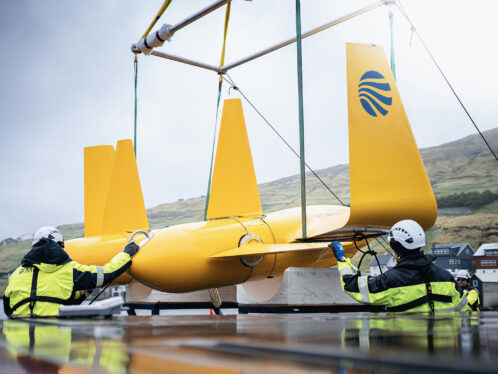
Beyond trucking
The logistics industry has grown from a simple warehouse-and-truck service business to a complex several trillion dollar industry that is at the core of any successful global enterprise.In an economy that seems to be spiralling towards recession, most companies are working within extremely tight profit margins, desperately trying to reduce costs while improving product variety and maintaining a high level of service and quality. At the same time, globalisation is putting pressure on companies to achieve this balancing act in an ever-widening and increasingly competitive global arena. In that kind of situation, overcapacity combined with problems in distribution of products and flow of materials in industrial processes can be disastrous.
That’s why logistics has become a powerful tool in modern-day business and is today an industry with an estimated worth of 3 trillion Euros. It is much more than simply providing warehouses and trucks. The explosive forces of globalisation, consolidation, centralisation, outsourcing and information technology are reshaping logistics. Increasingly complex and yet infinitely more efficient, logistics has become the lifeblood of a company: If it can’t get its products out, business comes to a halt.
“You’ve got diametrically opposed forces, where you’ve got globalisation and consolidation and standardisation facing market pressures, low prices and the need to offer more variety while also reducing costs. Basically, logistics is about trying to square this impossible circle,” says Alan Braithwaite, chairman of Logistics Consulting Partners in Berkhamsted, Herts, UK, a leading specialist consultancy in supply chain management and logistics.
There has already been a great deal of success in meeting this challenge. For instance, there have been huge achievements in underlying transportation economics. In the UK, says Braithwaite, the real costs of moving a parcel across the country for overnight delivery are 10 to 20 percent of what they were 20 years ago. This is the result of highly planned transportation networks, sophisticated materials-handling systems and information technology. This has also been enabled by improvements in road networks, through a combination of public and private investments in infrastructure.
And as Braithwaite points out, the real cost per slot on a container ship is 60 percent less than it was 20 years ago. “These are groundbreaking improvements,” he says. “They have enabled the logistics industry to respond to growth.”
Centralisation
Centralisation is yet another trend driving the direction of logistics. Companies first began centralising and rationalising manufacturing in response to overcapacity, and then they centralised distribution and logistics in response to pressures regarding cost. This allowed them to take advantage of huge improvements in transportation and logistics capabilities. The advantage of a single national or regional supply point is that companies can cope with the risk of variety much better. By holding stocks centrally, they can manage the product variety with lower inventories.
“This is important because variety in customer choice creates inventory, which creates a risk that inventory will become obsolete. And the costs of obsolescence are frightening,” says Braithwaite. “The computer industry, for example, is extremely vulnerable to obsolescence. But other industries, too, are desperately anxious not to have to sit and look at a lot of inventory. They don’t want to carry the costs of financing and storing that inventory. One of our clients, the telecom company Ericsson, achieved huge financial benefits when it centralised on a regional basis its repair and service operations.”
As the logistics industry has grown in complexity and sophistication, some giants have emerged, among them Deutsche Post, which owns DHL and Danzas, UK-based Exel and US-based UPS, which has growing operations in the rest of the world. These can be grouped in a category commonly referred to as third-party logistics service providers, in which a manufacturer hires a company to act on its behalf to run its distribution and logistics operations. Over the past several years there has been a 20 percent per annum growth in outsourcing revenues for logistics. This is expected to be a long-term trend. Increasingly, companies are finding that logistics at the operational level are not a core competency, and through third-party logistics they are achieving extraordinary reductions in costs.
For instance, third-party logistics companies often offer a whole suite of services, such as warehousing, distribution, customer fulfilment and a customer service centre as well as transportation. Outsourcing logistics is a matter of leveraging assets – for both partners.
Franchise environment
“We use our buying power to allow a company to use our services globally in a franchise environment,” explains Pete Westerman, business development director for the American logistics operations of UPS. “The customer is not putting up the capital; we are. But we are able to glean a reasonable profit while the customer gains better utilisation of their capitalisation. Technology has been driving a great deal of this trend. Companies are gaining increased visibility across their supply chains through greater access to data and information across multiple channels and partners.”
The growth of information technology has indeed revolutionised logistics. It has enabled companies to hook up on a regional or global basis to provide common transactional frameworks and visibility, both of inventory and strategy.
“That means a company can run its global business on a single database,” says Braithwaite. “If you are in Boston, you can tap into your system and see what the manufacturing schedule and inventory status is like in Brazil. We tend to take this kind of knowledge for granted today, but it is groundbreaking. Information technology has effectively enabled globalisation. It has allowed markets to connect with the central supply infrastructure both quickly and accurately.”
As with all paradigm-shifting changes, the advent of modern-day logistics has not come without some problems. The technology doesn’t always work the first – or even the second – time. And as Braithwaite points out, the cultural and organisational alignment of business from country to country has been very difficult.
Ian Chong, director of business development in Europe, Africa and the Middle East for UPS Logistics Group, finds that in Europe these differences are magnified by the vast range of geographical and cultural differences over a relatively small landmass. “As you trade among these countries, you find a lot more variations in fiscal matters, in data structure, which makes logistics a more complex challenge.”
Environmental pressures
Another challenge is environmental pressures. Braithwaite predicts that governments will have a massive challenge in figuring out how to handle the sort of trends that are driving growth and competitiveness, and not stifle these trends while also dealing with the negative impacts on the environment.
Once again, says Chong, these environmental constraints are magnified in Europe, where demand for road construction, taxation and volume is increasing. “If the infrastructure is going to continue to be constrained, more cooperation will be required among players in the marketplace.”
Several governments of European countries are enforcing what is called reverse logistics – for example, taking back the refrigerator the customer no longer needs, recovering the hazardous materials and then feeding the appliance back into the manufacturing chain.
While most companies are, as yet, slow to alter logistics in light of environmental considerations, Braithwaite predicts that other trends will be embraced in a big way. He describes a whole range of new systems enabled by the Internet, loosely described as end-to-end visibility and collaborative systems, which allow companies to look across inter-company boundaries and start to coordinate their activities much more closely with their trading partners.
“That’s going to be the big thing of the future,” he says. “You log onto the Internet and are able to see the status of your distributor in Singapore, who will automatically send you sales and inventory status across the Internet, so together you can agree what shipments you need to make. This is a huge opportunity for business process integration. We’ve done this in a couple of cases across Europe, and it has the potential to take about 40 percent of the inventory out of the entire chain.”
In addition, says Braithwaite, this tightly coupled system of information integration and visibility will allow companies to reconfigure their manufacturing operations to respond to low-volume requests for product variety. Such items will typically be made almost on demand and air-freighted around the world. “This provides a whole new mechanism of fulfilling customer choice.”
Amy Brown
a Stockholm-based journalist specialising in business, technology and the environment




